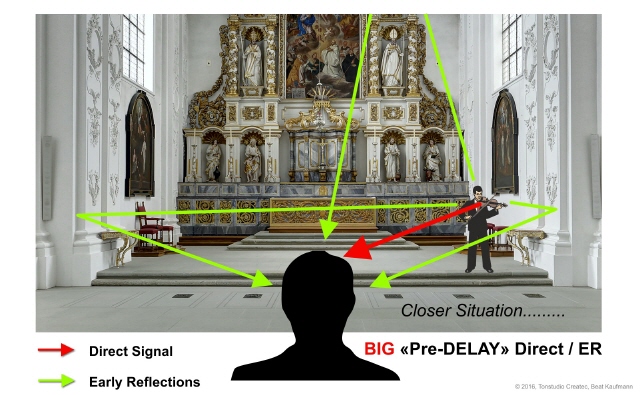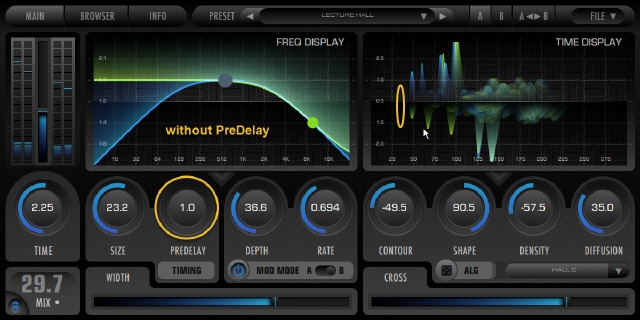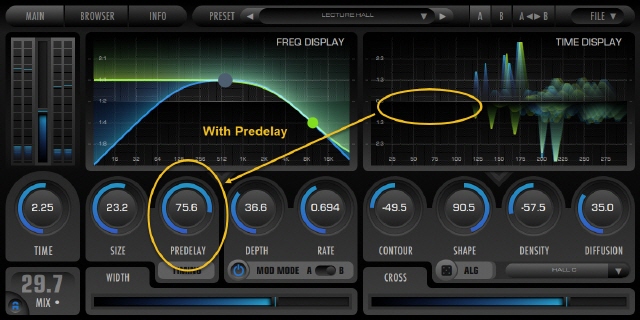About Reverbs
- Intro
- Reverb Type
- Predelay
- Early Reflections
- Time
- Filter
- Convolution-R.
- Final
Reverbs - hardware or software - are used to artificially simulate acoustics of rooms.
To date, there are roughly 4 approaches to how this can be done:
Mechanical reverb devices
A) You play the music to be heard through loudspeakers in a specially created reverberation room and record them with microphones again.
B) You play the music with transformers on plates or springs and picks up the vibrations at the other end again. This creates a kind of reverb.
Electronic reverb devices
C) Algorithms are created that simulate the decay of sound waves as naturally as possible. Today, some plug-ins can do this so well and cheaply that the entire mechanical Hall production hardly comes into play. = This sort of reverbs is called Algorithmic Reverbs
D) You create an acoustic image of a desired room by playing back suitable measuring signals. These measurement signals are picked up and charged into a so-called "Impulse Response" (IR). Special software "interweaves" these IRs into the music. This sort of reverbs is called Convolution Reverbs

Basically today's reverb plug-ins offer different reverberation rooms. For some, the parameter "Reverb-Type" is called "Room-Size".
Accordingly, settings are then called
- Small Rooms
- Chamber
- Hall
- Church
- Cathedra
- Plate / Spring
... and so on.

When working with orchestral samples, "Chamber" / "Hall" / "Church" are often a good choice. With this you select an algorithm that simulates concert halls as accurately as possible.
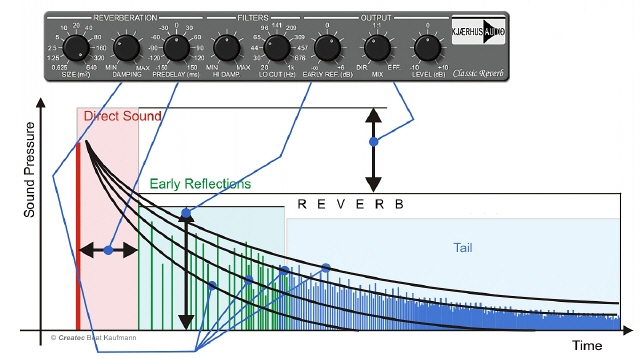
This value sets when the entire reverb process should start. Imagine standing in the middle of a cathedral. If you clap your hands, it will be a while before the first reflection comes back from the walls (if you do not take the floor into account). So "Predelay" sets the time that passes from direct sound to the arrival of the first reflections.
2 Examples of simulation in a cathedral:
A) Your colleague is standing near you and claps his hands... A large pre-delay time must be set (25ms to 100ms). By the way: For 1m the sound needs 3ms.
B) Your colleague stands far away from you in the cathedral and claps his hands... The direct sound reaches you only a little earlier than the first reflections. A small predelay time must be set (0ms to 10ms).
So that means:
Small pre-delay times = far away sound source
Big pre-delay times = nearby sound source
The first reflections that reach our ear evaluates our brains to learn about the space and distance of the sound source.
These Early Reflections (ER) are the key to what we want to do with our reverb effect.
If we want to set an instrument far away from us - into the depth of the room, you need a reverb with early reflections that can solve this task.
Unfortunately, not all reverb plug-ins can solve the tasks described here equally well. Test your reverb collection ...
These Early Reflections create no Depth
Early Reflections create Depth
Reverberation actually consists of the direct signal, the early reflections, and finally, so many reflections come together that they all together form the actual reverb. One often calls this part "tail". Time usually sets the total reverb time over all. So this parameter allows you to set how long it takes for the reverb to disappear (-60dB). Because the ERs take only a short time, "time" can actually be equated with the tail - the release time of the sound.
Often associated with this is also a filter with which you can make the frequency more and more dull over the reverberation time. That sometimes means "Damp". Often there is also a controller with which one can adjust the space-complexity (number of corners, wall surfaces etc.). This regulator is often called "diffusion". See below...
Tail without Depth
Tail with Depth in the meantime
A reverb can sound dull, thin, bright. To simulate these sounds, reverbs often have filters that can directly affect the reverb signal. Some reverbs already have such filters on the input so that e.g. low-frequency signals certainly do not get into the effect.
Reverb Signal not Filtered. For the distance the signal sounds too brilliant and too much inflated in the low frequencies
The Reverb Signal is filtered in the heights. The signal sounds more natural now but still "blowed up" in the low frequency range.
without any filter
with damped heights
with damped heights and a "pre" EQ
As already mentioned, convolution reverbs use so-called Impulse Responses from the right rooms. Because these are "static snapshots", algorithmic reverbs usually sound a bit more natural when they fade out. The strength of the IRs, however, is to create fairly natural, acoustic distances (depths). So if you only use the first part of the IR (0-400ms approx.) You get a nice room depth. With an algo-reverb you can add the tail - the reverb is perfect.
A) Look for IRs in your Convolution Reverb that will make the music sound far away at 100% wet. The Early Reflections are in the first 300-400ms. Only this we want to use now ...
B) If you have the option, shorten the IR to about 1.5s in total. Now the area with the Early Reflections is larger in proportion and better to work.
Sound with complete IR
Sound with shortened IR (to ER)
Sound with ER and some Tail (from Algo-Reverb)
So it's always crucial what you want from a reverb.
> A) Should it push instruments in different depths - but without Tail?
> B) Should it bring a mix to shine with a beautiful tail ? ...But without depth again?
> C) Should it add a reverb tail to a soloist without moving him to the back at the same time?
All that can reverbs do, but Not all can do it equally well.
That's why you have to get to know your own tools.
Check them out about ERs for depth / Tails without depth
Now you know a bit more what all the parameters are for.
See also Creating Depths with BREEZE2 and within Videos Synchron Player
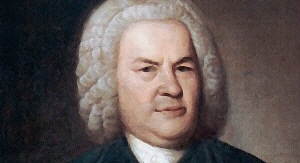
Let's finish the theme of "Reverb" with music...
... of course played with samples and mixed with created depths and a tail ...
Bachs Violin Concerto BWV 1041 (excerpt), played with VSL-samples. The orchestra plays in a certain distance...
... and the solo violin sounds closer to the listener (no ER only Tail) ...because it should sound as soloist.
Also see at Creating Depths with BREEZE2
© Copyright, Createc Beat Kaufmann, 2004 - 2025


